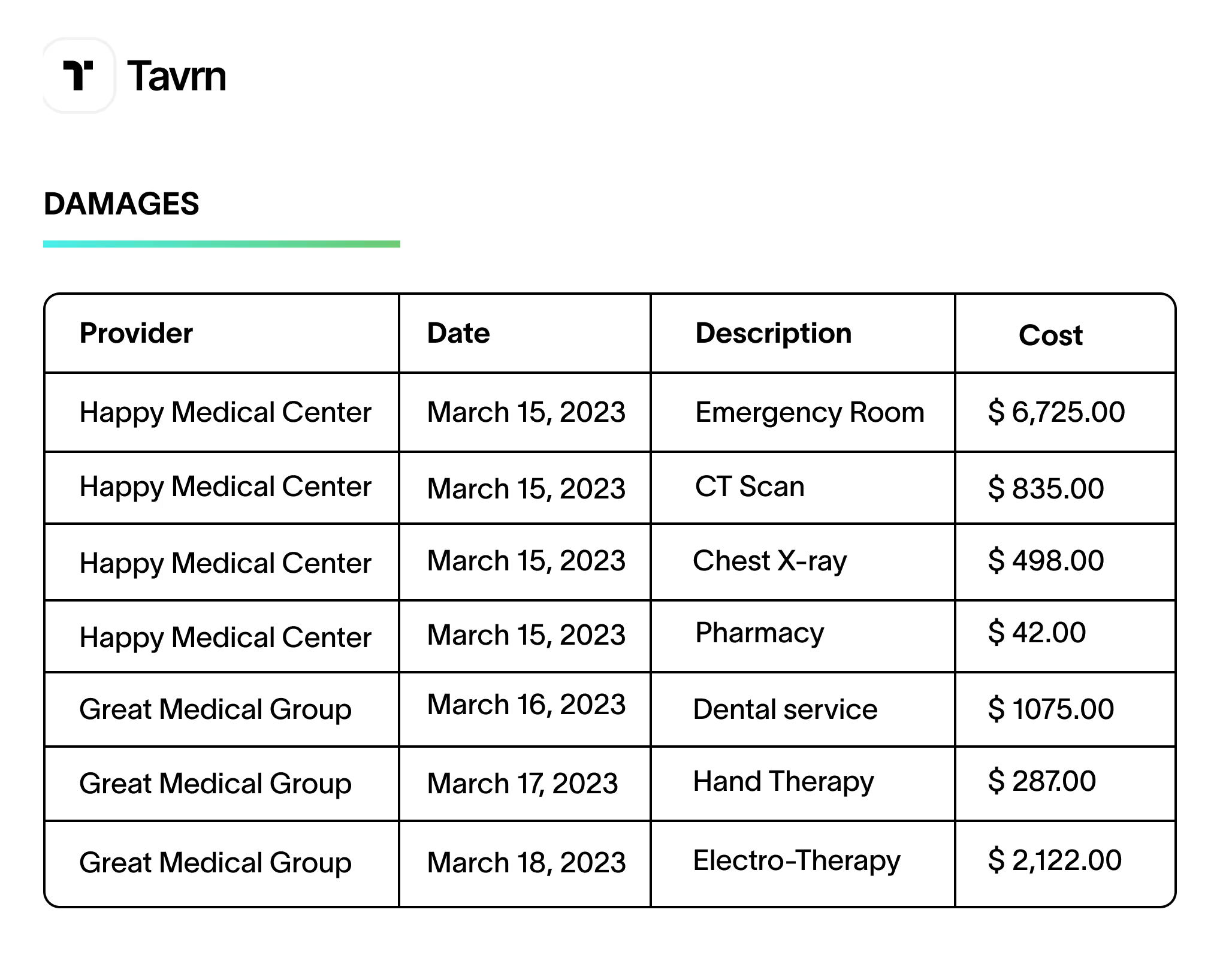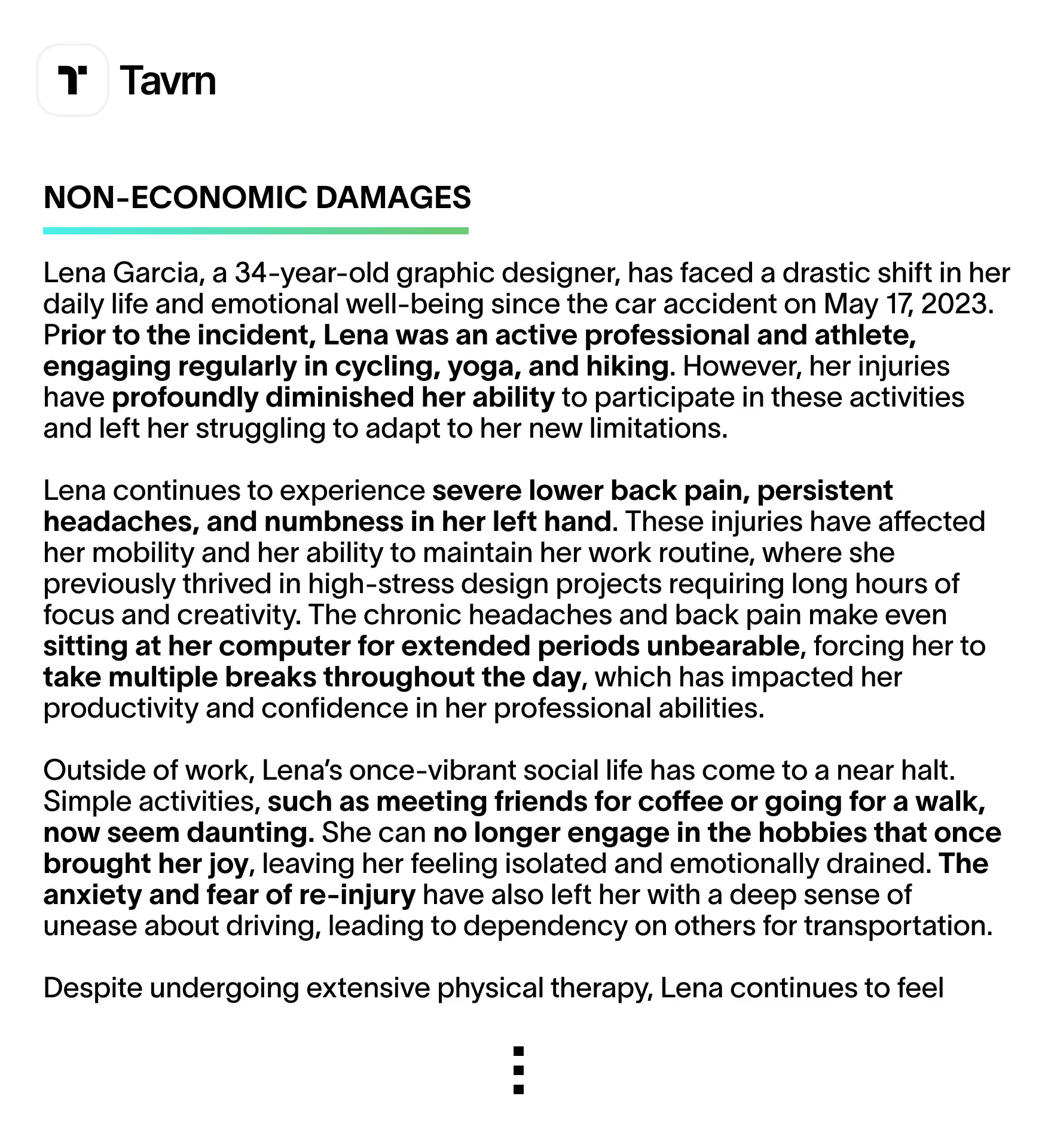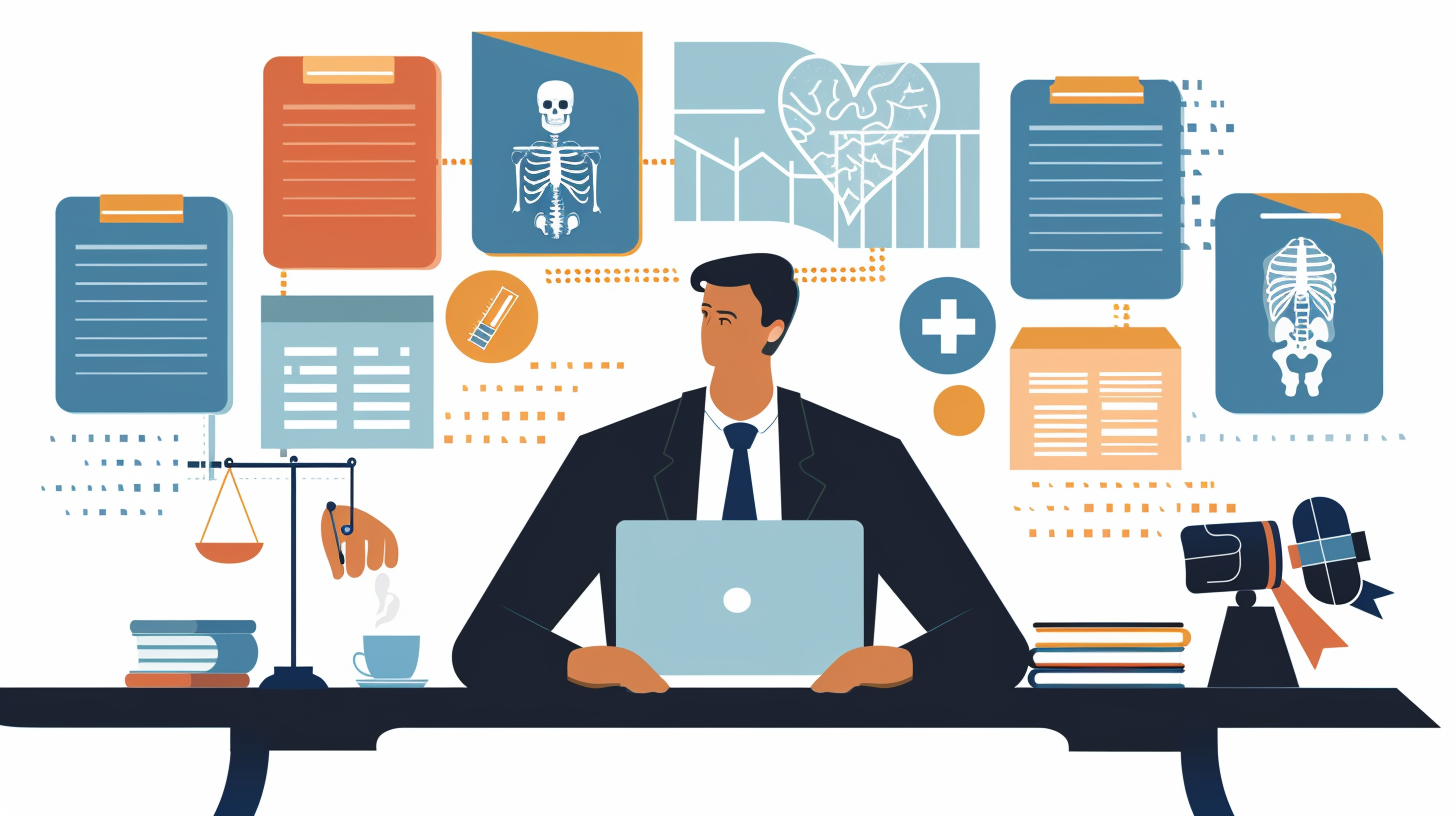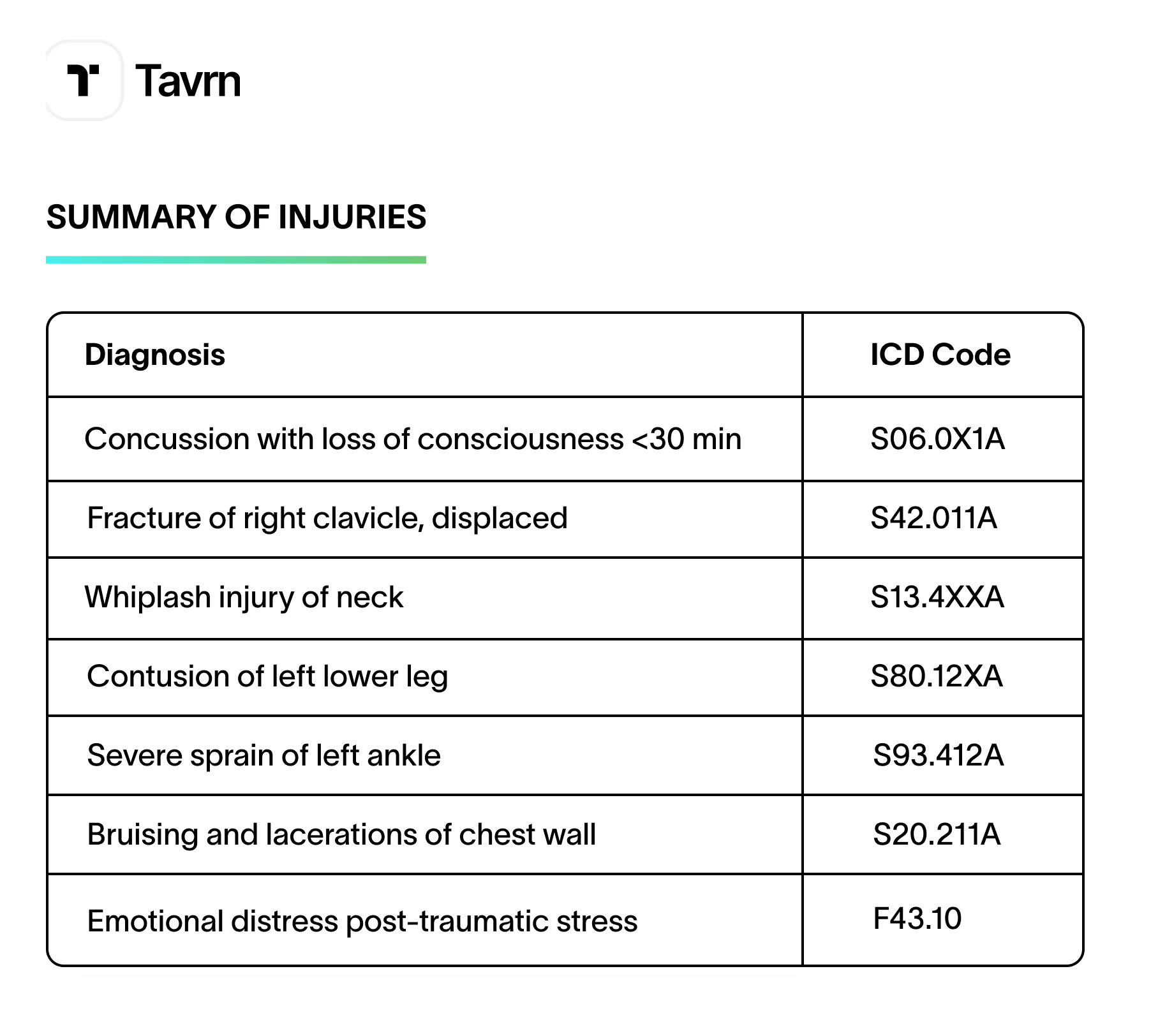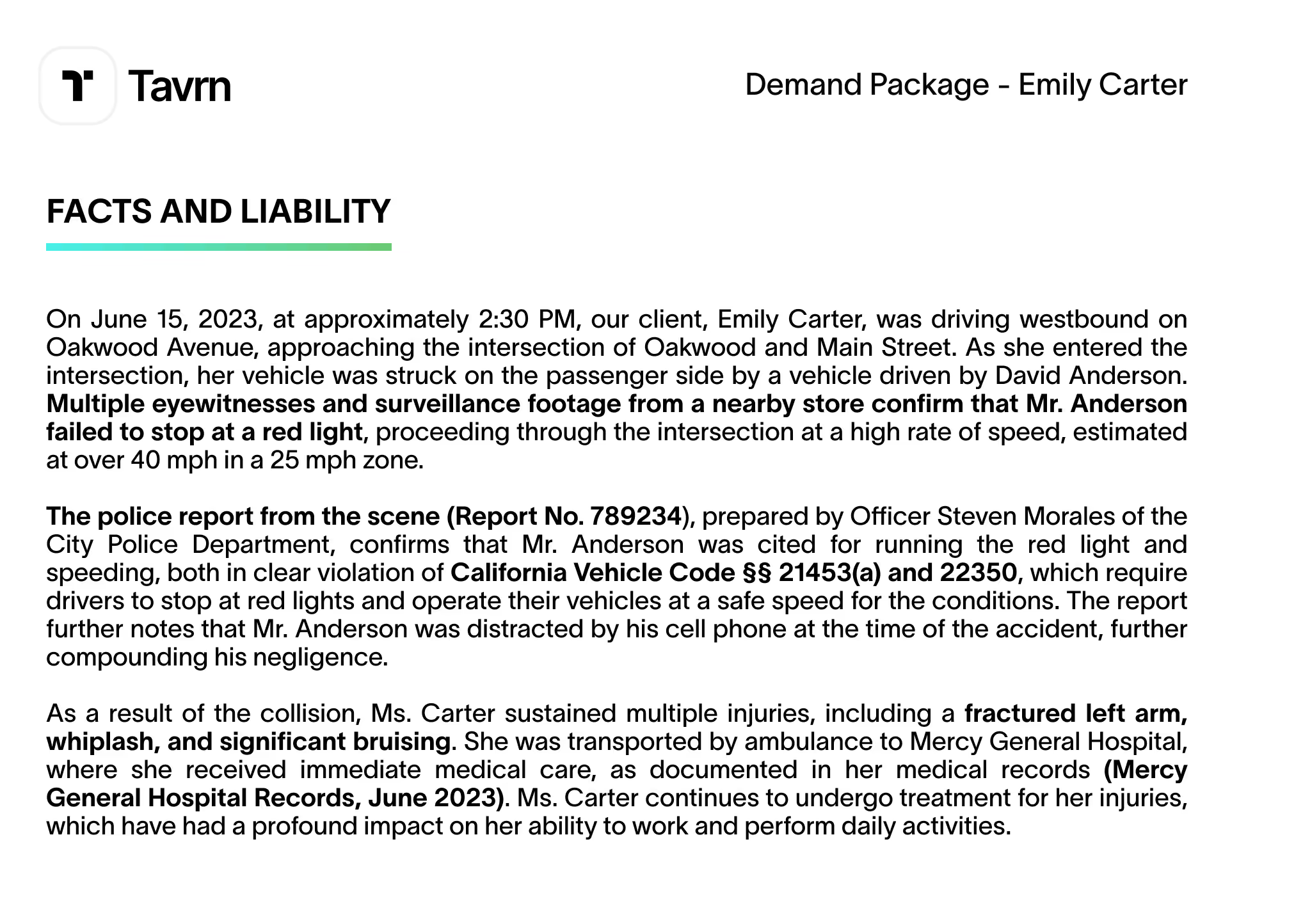How Are Medical Record Summaries Useful for Attorneys? A Comprehensive Guide
Medical records are critical in personal injury, medical malpractice, and workers' compensation cases—but only if they're clear, organized, and accessible. Attorneys lose valuable time sorting through thousands of pages of technical jargon, handwritten notes, and redundant details, increasing the risk of missing key facts.
A well-structured medical record summary eliminates the clutter, providing a concise, chronological overview of injuries, treatments, and diagnoses. AI-enhanced solutions further streamline this process, automating data extraction and structuring records in minutes instead of hours.
This guide explores why medical record summaries are essential, how to structure them effectively, and how AI-driven tools like Tavrn help law firms process medical data with greater speed, accuracy, and efficiency.
The Value of Preparing Medical Record Summaries for Attorneys
Disorganized medical records slow cases down and increase the risk of oversight. Attorneys need structured, case-focused summaries highlighting key injuries, treatments, and timelines—not thousands of pages filled with redundant details.
Medical record summaries turn raw data into clear, case-ready insights. Organizing records chronologically and eliminating irrelevant information allows attorneys to focus on case strategy, not paperwork. AI-powered solutions enhance this process, automating data extraction and delivering structured summaries in minutes.
Key Benefits of Medical Record Summaries for Attorneys
- Faster case analysis – Instead of spending hours combing through disorganized records, attorneys receive a structured medical chart summary in minutes. Intelligent automation ensures that only relevant data is included, reducing review time and allowing legal teams to focus on case strategy, not paperwork.
- A clearer understanding of medical history – A well-organized summary highlights injuries, treatments, and prognosis in a way that is easy to reference. AI-driven categorization eliminates clutter, ensuring every critical medical event is accounted for.
- Stronger legal arguments – Accurate, well-documented medical timelines reduce ambiguity, helping attorneys prove causation and justify damages. By structuring the information logically, AI-powered summaries make it harder for insurers to dispute claims or undervalue settlements.
- Improved negotiation and litigation strategy – A chronological record of injuries and treatments strengthens an attorney's position, providing compelling medical evidence that supports settlement discussions and trial arguments. AI-enhanced summaries highlight inconsistencies and gaps, allowing attorneys to anticipate and counter opposing counsel's challenges.
- Easier communication with medical experts – Physicians and expert witnesses can review a structured summary instead of navigating full medical records, making depositions and trial testimony preparation more efficient. AI-powered tools filter out redundant data, delivering what's relevant to the case.
- Cost and time savings – Manual medical record review is expensive and inefficient. AI-powered summaries cut unnecessary labor costs, streamline document organization, and allow firms to handle more cases without sacrificing quality.
By integrating Tavrn's AI-driven medical summarization, attorneys replace manual inefficiencies with structured, reliable case evidence—freeing up time for strategy, negotiations, and trial preparation.
What to Consider When Preparing a Medical Record Summary
A medical record summary isn't just paperwork—it's a legal tool that can make or break a case. When well-structured, it provides a clear medical timeline, establishes causation, and reinforces damages claims. But if records are disorganized, filled with technical jargon, or missing key details, they create delays, weak negotiation leverage, and opportunities for insurers to dispute claims.
Key Considerations
To ensure medical record summaries are litigation-ready, attorneys must focus on these critical factors:
- Maintain a clear medical timeline – A case is only as strong as its evidence, and an unstructured summary can leave crucial gaps. Medical events should be organized chronologically, forming a cohesive, fact-based narrative. AI-powered tools eliminate the risk of disorganized records by auto-sorting treatments, diagnoses, and physician notes into a structured timeline.
- Translate medical jargon into actionable insights – Complex terminology adds unnecessary barriers in legal proceedings. Summaries should clarify medical conditions, procedures, and prognoses in terms that strengthen a case. Machine learning technology extracts key medical facts, filtering out irrelevant details while maintaining accuracy.
- Focus on injuries and treatments that impact legal claims – A legal argument is built on relevant medical details, not excess documentation. The summary should highlight diagnoses, treatments, and long-term medical implications that affect settlement value. AI-powered extraction pinpoints only the most significant data, preventing attorneys from wasting time sifting through unrelated medical history.
- Flag missing records and inconsistencies before insurers do – Unexplained treatment gaps or conflicting medical reports can jeopardize a claim's credibility. AI-driven document review automatically detects inconsistencies, missing treatments, or red flags, allowing attorneys to address issues proactively instead of reacting to insurer objections.
- Eliminate costly errors – Small mistakes—like incorrect dates or misinterpreted diagnoses—can weaken legal arguments or provide insurers with grounds to dispute claims. AI-powered cross-referencing ensures extracted data matches original medical records, giving attorneys confidence in the accuracy of their documentation.
An AI-driven medical records summarizer removes the burden of manual review, ensuring every summary is accurate, structured, and ready for litigation.
How Medical Record Summaries Strengthen Personal Injury and Malpractice Cases
Medical records aren't just evidence—they're the backbone of personal injury, malpractice, and workers' compensation claims. Establishing liability and proving damages require a clear, structured medical history, but raw records are often disorganized and redundant.
AI-powered medical summaries transform complex data into a cohesive, chronological format, identifying key patterns and flagging inconsistencies. Attorneys can quickly extract relevant details, counter disputes, and negotiate stronger settlements—without getting lost in paperwork.
How Medical Record Summaries Support Legal Cases
- Personal injury claims – A strong summary links accidents directly to injuries, reinforcing causation. AI-powered medical timelines map symptoms, treatments, and diagnoses to specific events, preventing insurers from downplaying the severity or cause of an injury.
- Medical malpractice lawsuits – Proving malpractice requires precise timelines of care, missed diagnoses, or treatment errors. AI-driven reports flag discrepancies in patient records, delayed treatments, or deviations from standard medical protocols, strengthening negligence claims.
- Workers' compensation cases – A structured summary ensures that work-related injuries are well-documented, making it harder for insurers to deny coverage. AI-powered categorization links injuries directly to workplace incidents, reducing disputes over causation.
- Wrongful death and disability claims – Establishing how medical negligence or untreated conditions led to fatalities or permanent impairment requires a clear timeline. AI-generated summaries track medical deterioration over time, ensuring every relevant factor is included in settlement discussions.
By replacing manual sorting with AI-driven organization, attorneys can focus on case strategy instead of document review.
The Future of Medical Records Summarization: AI vs. Traditional Methods
Traditional medical record summarization is slow, inconsistent, and costly. Manual review wastes time, can increase errors, and weaken settlement leverage. AI solutions eliminate these inefficiencies, delivering structured, case-ready summaries in minutes.
Manual Medical Record Summarization: The Challenges
- Slow turnaround times – Reviewing medical records manually takes days or weeks, delaying negotiations and case filings.
- Risk of human error – Missing a single treatment date, misdiagnosed condition, or prescription record can weaken a claim.
- Inconsistent formatting – Different legal teams summarize records in varied formats, making it difficult to maintain standardization across cases.
- High costs – Hiring medical professionals or paralegals to manually summarize records adds significant expenses to legal operations.
AI-Powered Medical Record Summarization: The Solution
- Instant case insights – AI scans and categorizes thousands of pages in minutes, ensuring attorneys have all necessary medical details at their fingertips.
- Consistent, standardized summaries – Automated processing structures records into clear, legally optimized formats, making case review seamless.
- Cost-effective legal preparation – Eliminating manual review fees allows firms to allocate resources toward litigation strategy rather than administrative tasks.
- Smarter search capabilities – Attorneys can pinpoint critical medical details instantly using keyword and condition-based search functions.
Tavrn's AI-powered OCR technology even processes handwritten and poorly formatted records, ensuring nothing is overlooked.
Simplify Case Preparation with AI-Powered Medical Record Chronologies from Tavrn
Disorganized medical records slow litigation, increase costs, and create gaps insurers can exploit. Attorneys need structured, case-ready summaries to streamline case preparation, strengthen claims, and eliminate inefficiencies. Manual summarization is too slow and inconsistent—AI-driven solutions offer a smarter alternative.
Tavrn's AI-powered medical record summary services instantly extract, categorize, and structure medical data, saving attorneys time and ensuring accuracy. With searchable, organized reports, legal teams can quickly pinpoint key injuries, track treatments, and build stronger cases—without sifting through excessive documentation.
Firms using AI-enhanced medical record summaries resolve cases faster, reduce administrative workload, and position themselves for stronger negotiations. Don't let outdated methods slow you down—get precise, cost-effective legal document preparation with Tavrn's medical record chronologies.
Settle quicker and for more with Tavrn's AI-powered products now.
